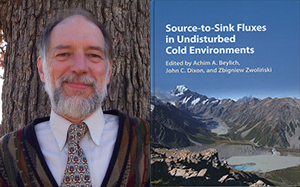New Book Co-Edited by U of A Geoscientist Examines Cold Environments
FAYETTEVILLE, Ark. – A new book co-edited by a University of Arkansas geoscientist describes the diversity of artic and alpine climates, and how they are susceptible to climate change.
The book, Source-to-Sink Fluxes in Undisturbed Cold Environments, provides an overview of the latest research of the working group of the International Association of Geomorphologists, said John C. Dixon, professor in the Department of Geosciences in the J. William Fulbright College of Arts and Sciences.
Forty-four scientists worldwide contributed to the book, which includes case studies covering arctic, Antarctic and alpine environments.
“We identify the main factors accounting for differences in the amounts of solid and dissolved materials transported across cold climate landscapes,” Dixon said. “We also explain why there are variations in the amounts of solid and dissolved materials transported in different cold climate landscapes. This research has particular implications for water quality and nutrient availability in these ecologically sensitive environments.”
Over the past 12 years, the working group has been observing the presence and availability of ice and running water in the fall season – and also the availability of ground ice for moving surface materials around through freezing and thawing – at 36 test sites around the world.
The focus of the research has been to better understand the ways in which climate change in these sensitive environments are likely to impact the magnitude and frequency of landscape change, he said.
“We are seeing a window to what will happen less intensely at lower latitudes,” he said.
The book stresses that cold climates are not uniform in their appearance and in the processes that operate within them, Dixon said. There is much greater variability in alpine landscapes than other cold climates, for example.
“This is a reflection of things like the bedrock that dominates, the aspect of the valley, the amount of vegetation cover or surface debris,” he said. “All of these variables influence the rate at which materials are moved around on the Earth’s surface.”
Dixon co-edited the book with Achim A. Beylich of the Geological Survey of Norway and Zbigniew Zwolinski of the Institute of Geoecology and Geoinformation at Adam Mickiewicz University in Poland.
Source-to-Sink Fluxes in Undisturbed Cold Environments is published by Cambridge University Press.
Contacts
John C. Dixon, professor
Department of Geosciences
479-575-5808,
jcdixon@uark.edu
Chris Branam, research communications writer/editor
University Relations
479-575-4737,
cwbranam@uark.edu
Headlines
Affairs of the Heart
Find out how biomedical engineering professor Morten Jensen is developing innovative devices to produce better outcomes in cardiovascular medicine.
Students, Faculty and Alumni Kick Off Centennial Year of School of Law
Founded April 14, 1924, the School of Law faculty, students and alumni started the celebration of its centennial year with a Founders Day event and will continue with more commemorative events this coming fall.
Yearly Academic Award Winners, Ambassadors Recognized by Bumpers College
Schyler Angell, Lexi Dilbeck, Cason Frisby, Tanner Austin King, Anna Brooke Mathis, Carrie Ortel, Lucy Scholma, Kadence Trosper and student ambassadors were honored at the college's annual reception.
World Premiere of 'Cries from the Cotton Field' Slated for May 8
Cries from the Cotton Field chronicles the journey of 19th century Italian immigrants from northern Italy to the Arkansas Delta and ultimately to Tontitown. It will premier at 6 p.m. May 8 in Springdale Har-Ber High School.
Fay Jones School's Earth Day Event Spotlights Sustainable Materials and Projects
"One day doesn't seem like a lot, but one day can empower individuals and groups, energize them to work for change and innovate for transformative solutions," professor Jennifer Webb said of the students' design work.





